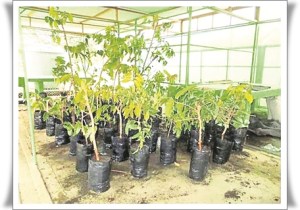
Raising tree crops from cuttings
National Agricultural Research Institute research officer MATHEW POIENOU writes about the non-mist method of growing crops from cuttings instead of using seeds and off soots

PAPUA NEW GUINEA is endowed with a diverse tropical range of fruits and nuts.
Some of these are tree crops such as galip, coconut, cocoa and coffee.
Many factors have made it impossible to fully harness their socio-economic potentials.
One of these challenges is the need to develop and maintain good seed systems.
In recent years, the National Agricultural Research Institute (Nari) has done trials at its Kerevat research centre in East New Britain to identify suitable methods for producing seeds and other forms of planting materials.
One of them is the possibility of generating large numbers of planting materials using non-mist propagator (NMP) nurseries.
These nurseries facilitate the breeding (rooting) of cuttings of tree crops, instead of using seeds and off-shoots.
There are many useful benefits of this technique for commercial farming of tropical tree fruits and nuts.
The non-mist method involves use of enclosed nurseries made of recommended plastic sheets or locally available materials.
Non-mist nurseries are designed to provide the right conditions for plant cuttings to develop roots and grow.
This is ideal for generating planting materials that can reproduce desired features of the parent crops.
The new plants are essentially clones of the parent material.
They have the potential to produce maximum fruit and nut yields of desired traits all year round, under required conditions.
This is beneficial for maintaining high quality of yields for commercial farming of fruit and nut trees.
Seasonal slump in supply is another challenge can be addressed as well.
These advantages can boost the market for emerging tree, cash crops.
For example, consistent supply of nuts of preferred qualities will help to maintain continuous production and sale of galip brands that meet satisfy commercial standards of taste and nutritional value.
Early maturity is another important advantage of plants bred using the non-mist method.

Tree crops raised in this way can bear earlier trees than those raised from seedlings that undergo slow, early development phases.
Rooted galip clones can mature and bear in about seven years.
Normally, it would take between 12 to 20 years.
This is helpful for commercial production as it involves less time, cost and effort in sustaining supply.
It is important that smallholder farmers obtain cuttings from healthy parent crops. There is risk of losing entire crops if a disease or pest attack occurs as clonal seedlings lack diversity.
Farmers can avoid this by using non-mist method to also establish backup collections of tree crops.
Smallholder farmers will have to acquire basic knowledge and skills to set up their own non-mist nurseries.
First, they have to establish a seed collection of diverse tree crops.
To obtain shoot cuttings, they will have to prune branches of the mature tree crops a couple of months prior to obtaining and growing cuttings in non-mist nurseries.
Success depends on careful management of important factors such as the amount of light and temperature as well as gas and water cycles inside the nurseries.
These factors ensure normal processes of photosynthesis, water and gas movements occur to encourage new shoot development and growth. Moisture also helps to maintain optimum temperatures (about 30 degree celsius) within the nurseries.
Results from Kerevat have demonstrated that when those factors are properly managed, it should be very easy to grow cuttings from tree crops such as galip, cocoa, baringtonia, eaglewood and taun.
Smallholder farmers can work on a one-chambered non-mist nursery for the mentioned tree crops with the help of experienced extension officers.
It can take months to master specific skills and knowledge for different crop species.
The rate of rooting among woody plants depends both on species as well as attention and effort on the part of the farmer or extension officer.
The author has identified best practices any interested farmer should observe.
These ranged from the initial phase of establishing a bud-wood garden and green house all the way to the actual construction and use of a one chamber, non-mist nursery.
This is based on his work and experience over the past 16 years.
Non-mist nurseries have been used in other tropical countries to develop clonal seed materials.
The method is new here but is slowly gaining interest from us and other leading national agricultural agencies such as the Forestry Research Institute and the Cocoa board.
The method has a lot of benefits.
It is easy to do in villages to mass produce clonal planting materials of tree crops both for cultivation in a farmer’s own farm and for distribution in response to requests from other farmers.
- Mathew Poienou is the research information officer based at NARI’s Islands Regional Centre at Kerevat, East New Britain.